Here’s my plan for sheep coats.
Coat parts from top left to right: 2 assembled leg pieces, chest piece, chest reinforcing, coat body folded in half.
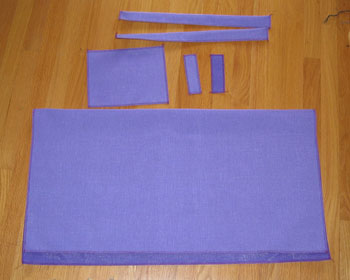
A fully assembled sheep coat.
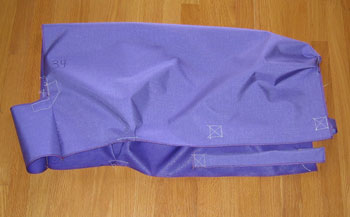
A fully assembled sheep coat from the inside. The chest piece is at the top, girth tucks are on the sides, and leg straps are on either side. Tail tucks are at the bottom.
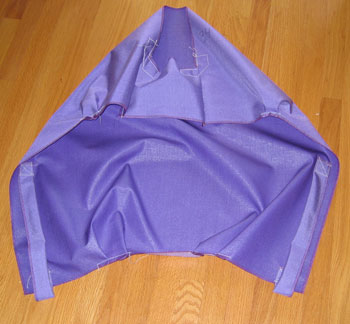
Here’s the fully assembled sheep coat inside out, showing the chest corner reinforcing strip.
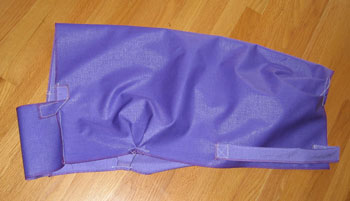
Here’s an up-close detail of the chest corner reinforcing strip.
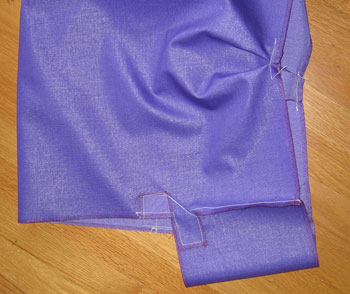
Here’s a close-up detail of the leg strap attachment.
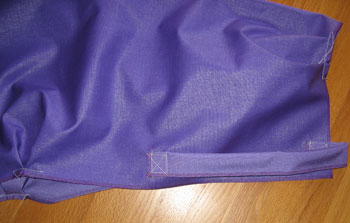
Here’s last year’s model on a sheep. This version was missing the girth tucks, and the leg straps are too long.
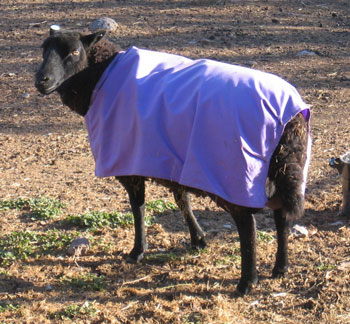
Here’s another version from last year. It has serged edges and girth tucks, but the leg straps aren’t quite right yet.
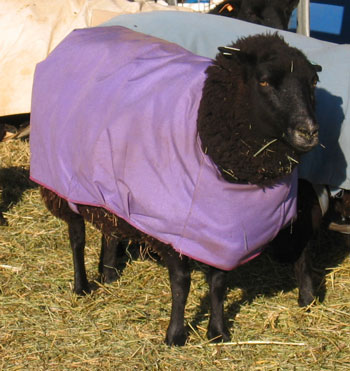
Here’s a side view of the coat above. You can see that the leg straps are way too big.
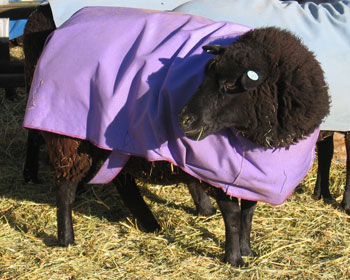
The coat design is fairly simple. For a size 34 coat, I cut a rectangle of fabric 34″ by 36″ for the coat body. The chest piece for a 34 is a rectangle – 10″ by 12″ for most sheep. They can be a bit larger if required. I make two small reinforcing pieces about 5″ by 1.5″ wide. Then, I make two leg straps that are 3.5″ wide by 15 ” long.
I use my serger to serge the edges on all sides of the coat body, chest piece, and reinforcing pieces. The leg straps are folded in half, good side out, and I use the serger around the three cut sides.
See the coat size table below for more info.
The coat is assembled by taking the chest piece and sewing it to the two front edges of the coat body. This gives more room for wide-chested sheep. Make the short side the height and the long side the width.
The two reinforcing pieces are sewn at the upper edge – specifically, at the right angle where the chest piece meets the body. I sew down one side, fold it in half, turn the corner, sew the other side, then sew all around the edges. Without the reinforcing pieces, the chest seams rip out.
Legs are attached at the back end and along each serged side, with the serged edge parallel to the serged bottom of the coat. The rounded, folded edge should be near the sheep’s udder. Be sure to leave a thumb’s width behind the back edge of the sheep coat for ease of use.
I take a girth tuck on each side, behind where the chest attaches, and put a gather there. I take 2-4 tail tucks along the top back edge so the coat doesn’t gape at the tail.
New parts for this design involve serging all the edges, but not rolling or making the seams more elaborate. It remains to be seen whether that works or not. I’ve done some serged edges on some repairs, but never the whole coats.
The hard part is attaching the two reinforcing pieces. Turning the coats to get the most forward section of the leg attachment is also challenging.
The best sewing sequence is to cut and serge all the parts. Set up for assembly-line sewing. Mark where the chest piece and leg straps will go on all your coats. After each seam, re-fold and set things up again for the next seam. Sew the chest piece to one side on all coats. Then, re-fold and sew the reinforcement to that side. Sew the leg straps on the back section first for each side. Then, turn the legs and sew them down. Sew the chest piece to the other side, then sew the reinforcement to that side. Pin the girth and tail tucks, then sew them all in sequence.
Size chart: all dimensions in inches
| Length | Width | Chest Height | Chest Width | Leg Strap | Girth Tuck? | Tail Tucks |
| 24 | 26 | 6 | 8 | 12 | No | 2 total |
| 26 | 28 | 6 | 8 | 12 | No | 2 total |
| 28 | 30 | 8 | 10 | 14 | No | 2 total |
| 30 | 32 | 9 | 11 | 14 | No | 2 total |
| 32 | 34 | 9 | 11 | 14 | Yes | 2 total |
| 34 | 36 | 10 | 12 | 16 | Yes | 4 total |
| 34W | 38 | 10 | 12 | 16 | Yes | 4 total |
| 34F | 42 | 10 | 12 | 16 | Yes | 4 total |
| 36 | 38 | 12 | 14 | 17 | Yes | 4 total |
| 36W | 40 | 12 | 14 | 17 | Yes | 4 total |
Your fabric choice is critical to a good coat. We’ve tried lots of things that do not work, including Cordura, ripstop, canvas, Sunbrella, etc. What does work is 120 denier nylon Oxford weave material. It lasts and breathes, and the wool does not felt under it. Unfortunately, it’s almost impossible to find. A suitable alternative is Seattle Fabrics 500 Denier Cordura Nylon. It is coated, but lightly, and the wool also does not felt with it if it’s not too tight.
We only coat our sheep when they come into the corrals in winter for hay. I typically plan on each adult ewe needing two or three coats over that time, as I start them smaller and increase the size as their wool grows. Lambs may take up to five coat changes as they grow over their first winter. It’s critical to change the coats as soon as the sheep get tight in them, or the wool will felt.
